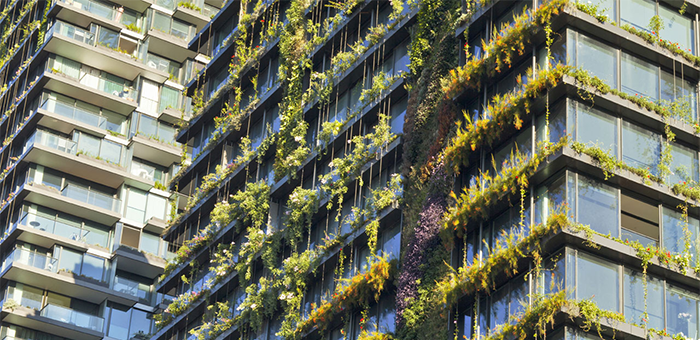With so much focus now turned toward environmental impact and sustainable design in contemporary architecture, it's no surprise that vertical gardens and other urban green spaces have soared in popularity.
At the moment, all eyes are poised on French botanist Patrick Blanc's work on the One Central Park development in Sydney, which was recently named the world's largest vertical garden. The 116 metre residential building is encased in more than 30,000 shrubs and 70,000 plants, which are attached to the building's structure by 21 large, vertical panels. While this stunning feature was purpose-built for a large scale residential development, in principal vertical gardens are highly scaleable — and can easily be adapted to buildings of any size or style.
The role of green space in architectural design
It can be argued that the sudden popularity of vertical gardens has occurred as a response to growing public demand for urban gardens. As more Australian businesses are adopting policies that reduce their environmental impact, architects are also becoming increasingly conscious of the need for green spaces in new construction. As a result we're seeing some brilliant examples of architectural innovation in creating living landscapes.
But it's not just about keeping up with public trend; green space provides several advantages that can be adapted from nature and transferred into the built environment. For instance, vertical gardens provide buffering from sound and insulation from heat to the interior of buildings, promote cleaner air, and ultimately create a beautiful, unique and natural aesthetic. Furthermore, depending on the choice of plants used, it may lead to reductions in water use and costs of traditional garden maintenance.
How to incorporate a vertical garden into your design
There are no rules on where vertical gardens should be placed, how they should look or the types of plants that should be included in their design. The artistic opportunities for vertical garden design are unlimited — however, there are some important considerations that should be made when deciding what types of materials will be used, to ensure the structural integrity of the building is not compromised.
The first step to building any vertical garden — whether it be a large scale construction or a small feature in a residential property — is to establish a secure frame. Products such as Latham’s grates and frames are ideal for this purpose; when installed vertically, they provide a surface from which planters, pots and soil-less greenery can be attached, without being obtrusive or spoiling overall appearance. The Lathamgrate™ aluminium and brass trench gratings and frames — while traditionally used as safety flooring systems in architectural design — can also be custom manufactured to the required width of your application, allowing you to replicate the same effect seen in some of today's most exciting examples of vertical garden design.
Australian vertical garden design: some inspiration
Further inspiration can be sought from one of Australia's most well-known proponents of the vertical garden — designer and restaurateur Joost Bakker. His trademark green spaces include Greenhouse Perth and Greenhouse Sydney, where lush, living walls of flora are a feature proudly as a key element of building design. Bakker is committed to using recycled materials and architectural building products for alternative uses, in order to facilitate a constructed environment that more closely aligns with our natural one.
Famous for his work on Sydney’s tallest vertical garden at One Central Park, Patrick Blanc has made a career from the creation of non-traditional green spaces. His designs have been implemented in built landscapes everywhere from Miami and Paris, to Melbourne and Dubai — and demonstrate just how clever architecture can adapt to, and harness, the outdoor environment for sustainable living.
For more information on the types of premium quality architectural materials that can be utilised in the construction of vertical gardens, visit the Latham website, or contact us to chat to our staff.
To find out more about Latham products, please visit www.latham-australia.com. To talk to a Latham product expert, call 1300 LATHAM (528 426) or email sales@latham-australia.com.



